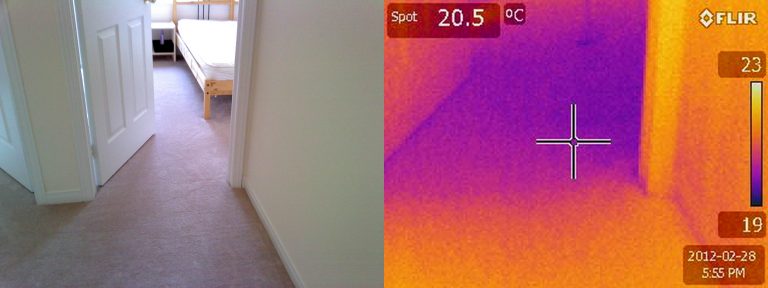Thermal Imaging during a home inspection...What it can uncover.
Thermography, Infared or Thermal Imaging, has been around for many years now. I personally think this should be a must when you are doing a home inspection as it provides so much value to my clients which is why I include it Free with every inspection. It a great way to narrow down issues during a home inspection, and lets face it, its pretty cool as well.
When I was a certified with the FLIR Thermography training it was mind-blowing to find out all of the things these cameras are used for. Everything from electrical to now diagnosing cancer. Technology is a wonderful thing isn't it.
I figured because its such an interesting topic I wanted to share how I use thermal imaging during my inspections to find my prey...The "construction defect".
Missing Wall Insulation
During the winter, missing wall insulation shows up as a cold area. There is no mistaking this photo where the dark blue area shows that the wall temperature is significantly different the neighbouring wall areas.
Thermal imaging for home inspection
Missing or
Displaced Attic Insulation
This picture of the master bedroom was taken on a warm spring day where the sun was shining on the roof, creating a very warm attic. The missing attic insulation is hard to miss. I bet the home owners never knew why their bedroom so hot in the summer.
Inadequate Garage Ceiling Insulation
How many people have bought a brand new house only to find the room over the garage is super cold in the winter? As there is no way to see this concealed insulation, the best way to assess the performance of the house is to check it during the winter months. While you could feel the cold in your feet, the thermal camera allows you to check the temperature difference and provide documentation that could be used as evidence to prompt the home builder or owner to make repairs. In this house you can see the 4 deg C difference between the bedroom and the hallway.
Foundation Water Leaks
While thermal cameras show temperature, under the right conditions they will often show wet areas as well. When the air is dry you get evaporative cooling as the heat leaves the surfaces in vaporized water, leaving the damp areas colder than the surrounding dry regions. This was the basement of a home that has a foundation water leak from a sprinkler system. While there was very little evidence that you could see with your eyes, the wet carpet (and my hot foot prints) are evident in the thermal data. Pretty cool hey!
Plumbing Leaks
In this home, I noted that the shower head piping in the newly renovated 2nd floor bathroom seemed quite loose when I inspected it. Slightly suspicious, I used the thermal camera to scan the ceiling of the room below and detected the location where the water was dripping onto the living room ceiling. I was able to confirm that the area was wet using my moisture meter. There was not yet staining on the ceiling that would suggest a leak. This would have been very hard to find without the camera.
Rodent Activity
I sometimes find signs of rodent activity in a house but it can be difficult to gauge the extent of the problem. Often the rodents will tunnel in the wall or attic insulation leaving air pockets as they displace the insulation. The extent of the problem may not be evident without the use of this tool. Eeeak...coming from someone who has had mice fall on them during an inspection, this gives me goosebumps.
Radiant Heating Performance
The camera is also a great way to quickly check the performance and placement of radiant in-floor heating. The location of the heating elements is very obvious but can be difficult to gauge when using your hands to try to judge where and how warm the floor is. Its a great way to make sure it is fully working.
In Summary
So Thermography is pretty cool...These cameras have come a long way even over the last few years, and they are just getting better and better. I think its important to have an inspector that has a construction background to understand homes as a whole as well as one that wants to provide you the best possible inspection by having the proper tools to assist with the job.
That's only a few examples of what these cameras can do. They also can find an electrical defect such as an overheating wire, circuit breaker or receptacle as well as diagnose hidden Stucco water damage.
Until next time.
Ryan Davidson - Owner House to Home Inspections.
House to Home Inspections - Calgary, AB







